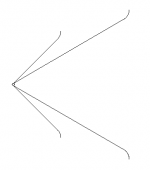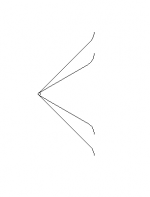A waveguide with different angles on H&V promises to help with ceiling reflections, and even reduce baffle spacing.. but does it achieve these goals?
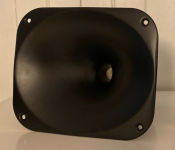
If you want to make the vertical dimension more narrow and still have it work down to the same frequency, it needs to be both taller and deeper. This trade off is the opposite of what you often see . Eg 90 x 50 ...

When the mouth is cut down to a flat face for flush mounting, the mouth becomes short and wide, and the short vertical dimension relatively loses control of the lower frequencies. This leads to raising the crossover frequency which reduces crossover wavelengths.
The effective driver spacing is increased quicker than the waveguide size, making baffle spacing greater than for a wider angle.

If you want to make the vertical dimension more narrow and still have it work down to the same frequency, it needs to be both taller and deeper. This trade off is the opposite of what you often see . Eg 90 x 50 ...
When the mouth is cut down to a flat face for flush mounting, the mouth becomes short and wide, and the short vertical dimension relatively loses control of the lower frequencies. This leads to raising the crossover frequency which reduces crossover wavelengths.
The effective driver spacing is increased quicker than the waveguide size, making baffle spacing greater than for a wider angle.
Example
When you need 90 horizontal and 60 vertical to the same lower frequency, they should differ as shown.. (the roundover, waveguide length and mouth size are each increased)
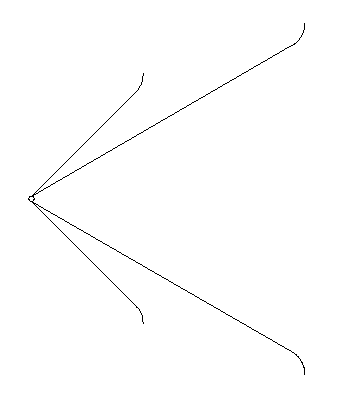
So, if you cut a 60 x 90 down flat like shown below, the crossover lower limit goes up an octave and a half compared to a regular 90 x 90 or axisymmetric waveguide..
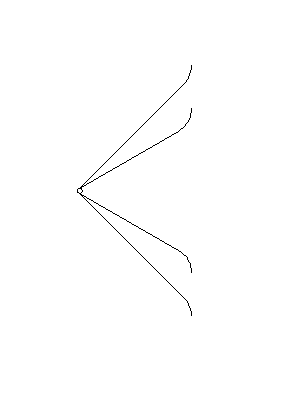
When you need 90 horizontal and 60 vertical to the same lower frequency, they should differ as shown.. (the roundover, waveguide length and mouth size are each increased)
So, if you cut a 60 x 90 down flat like shown below, the crossover lower limit goes up an octave and a half compared to a regular 90 x 90 or axisymmetric waveguide..
Suggestions
1. Consider a ceiling absorber, which can easily be more effective (in dB reduction) than using a full sized narrow waveguide, and the axisymmetrical waveguide will better match the driver diaphragm shape.
2. If you design a non-axisymmetric waveguide, know the angle of the ceiling reflection in your room, and try not to go needlessly narrow.
3. Close baffle spacing is not essential for a good cross. In any case it needs to be properly accounted for.
4. If a waveguide struggles controlling the lower frequencies, it may 'notice' being at the top of a baffle when the bottom has an extended baffle area below it, tilting the output.
5. Curvature (expansion) can raise the lower effective frequency compared to using a more conical waveguide of the same size (length and mouth area).
-----
So when evaluating an existing waveguide, take note of the shortest mouth dimension because this sets the limit. Calculate or measure where the pattern 'flips', ie the frequency where the vertical has widened so much that it crosses the horizontal. Some waveguides might be ok crossed here, give or take for various reasons.

1. Consider a ceiling absorber, which can easily be more effective (in dB reduction) than using a full sized narrow waveguide, and the axisymmetrical waveguide will better match the driver diaphragm shape.
2. If you design a non-axisymmetric waveguide, know the angle of the ceiling reflection in your room, and try not to go needlessly narrow.
3. Close baffle spacing is not essential for a good cross. In any case it needs to be properly accounted for.
4. If a waveguide struggles controlling the lower frequencies, it may 'notice' being at the top of a baffle when the bottom has an extended baffle area below it, tilting the output.
5. Curvature (expansion) can raise the lower effective frequency compared to using a more conical waveguide of the same size (length and mouth area).
-----
So when evaluating an existing waveguide, take note of the shortest mouth dimension because this sets the limit. Calculate or measure where the pattern 'flips', ie the frequency where the vertical has widened so much that it crosses the horizontal. Some waveguides might be ok crossed here, give or take for various reasons.
Attachments
Yes, mouth height is reduced as vertical dispersion angle is reduced, while the opposite is desirable.
The horn losing vertical pattern control at low frequencies while horizontal dispersion is retained is also called 'pattern flip', as it now has a wider vertical dispersion than horizontal dispersion.
Altec Lansing attempted to reduce it in the Manta Ray horn.
The horn losing vertical pattern control at low frequencies while horizontal dispersion is retained is also called 'pattern flip', as it now has a wider vertical dispersion than horizontal dispersion.
Altec Lansing attempted to reduce it in the Manta Ray horn.
Last edited:
Good post AllenB. Asymmetric horn is counter intuitive, instead of saving space vertically they waste space horizontally if one thinks the device with crossover in mind. Also, as kimmosto has posted earlier this year c-c spacing can be ralaxed to 1.4 wavelenght at xo frequency for best power response the asymmetric devices feel obsolete (no need to pull tje waveguide close to woofer). There really is no reason to use one unless absolute minimum cabinet size is more important than audio quality. Availability is good though.
Wide dispersion speakers are well regarded so i would definitely take better crossover integration over narrow vertical dispersion and use symmetric waveguide. Axisymmetric feels most logical. I havent read studies about ceiling reflection so all this is my thinking and opinion.
Wide dispersion speakers are well regarded so i would definitely take better crossover integration over narrow vertical dispersion and use symmetric waveguide. Axisymmetric feels most logical. I havent read studies about ceiling reflection so all this is my thinking and opinion.
Last edited:
Prosound drivers and horns are generally designed with output in mind, not polar response.
For instance, that's an 18Sound XT1086, which is about 25cm wide, IIRC. It will maintain pattern control down to about 1350Hz.
Here's an 18Sound 1" compression driver:
Eighteen Sound Speakers - Eighteen Sound ND1060 - Eighteen Sound ND1060 1" high frequency compression driver has a lightweight neodymium magnet. Eighteen Sound ND1060 2" high frequency compression drivers are available here. 18 Sound speaker componen
It has a recommended crossover of 1600Hz.
In a nutshell, I agree with your conclusions: a symmetrical waveguide can work really well, and in a lot of cases it's more sensible to use a symmetrical waveguide and accept that your center-to-center spacing will be wide, instead of using an asymmetrical waveguide that allows tighter spacing but has directivity that falls apart at a higher frequency.
But having said all that, prosound compression drivers and waveguides aren't designed for the xover frequencies that we're using.
For instance, that's an 18Sound XT1086, which is about 25cm wide, IIRC. It will maintain pattern control down to about 1350Hz.
Here's an 18Sound 1" compression driver:
Eighteen Sound Speakers - Eighteen Sound ND1060 - Eighteen Sound ND1060 1" high frequency compression driver has a lightweight neodymium magnet. Eighteen Sound ND1060 2" high frequency compression drivers are available here. 18 Sound speaker componen
It has a recommended crossover of 1600Hz.
In a nutshell, I agree with your conclusions: a symmetrical waveguide can work really well, and in a lot of cases it's more sensible to use a symmetrical waveguide and accept that your center-to-center spacing will be wide, instead of using an asymmetrical waveguide that allows tighter spacing but has directivity that falls apart at a higher frequency.
But having said all that, prosound compression drivers and waveguides aren't designed for the xover frequencies that we're using.
On the datasheet pattern flip happens around 1800hz, while still pretty close to horizontal pattern below that though, it is 80x60 pattern so not too bad patternflip.
I'm still baffled why they do these asymmetric ones? I mean it could be smaller and perform pretty much the same being axisymmetric 60x60 or 80x80, altough few dB difference at off-axis. Maybe these are still made since they performed better before computer simulations allowed to optimize axisymmetric ones and are still done by tradition? I mean symmetric shape will amplify what ever issues there is (mouth reflection/diffraction). For optimized profile I see no reason to use asymmetric even in PA since it would be smaller in size and have better match to woofer at crossover. Maybe the 60 or 80 or 75 or 90 or whatever number is so important in pro audio market? It is very rare to see the speaker positioning to take advantage of the pattern they have though (i'm musician and see all kinds of small and large setups). I would like to know what is the thinkin, the advantage?
I'm still baffled why they do these asymmetric ones? I mean it could be smaller and perform pretty much the same being axisymmetric 60x60 or 80x80, altough few dB difference at off-axis. Maybe these are still made since they performed better before computer simulations allowed to optimize axisymmetric ones and are still done by tradition? I mean symmetric shape will amplify what ever issues there is (mouth reflection/diffraction). For optimized profile I see no reason to use asymmetric even in PA since it would be smaller in size and have better match to woofer at crossover. Maybe the 60 or 80 or 75 or 90 or whatever number is so important in pro audio market? It is very rare to see the speaker positioning to take advantage of the pattern they have though (i'm musician and see all kinds of small and large setups). I would like to know what is the thinkin, the advantage?
Last edited:
edit time over so another post: maybe the loading aspect will squeeze the last distortion free dB out of a compression driver while trying to have some horizontal dispersion for average audience size/venue? The XT1086 has even a small diffraction slot trying to widen the horizontal response out of deep horn? Anyway, for home use availability is good but otherwise it is not the best option to use, axisymmetric seems more logical for audio quality.
Yes, and while bringing the mouths together it uses the extra space for loading (B), or compromised for a square mouth (C).diffraction slot trying to widen the horizontal response out of deep horn?
Great visualization, thanks! so the compromize is mainly to have some loading with some dispersion at slight quality cost due to diffraction slot (HOMs). In my view simply SPL over quality, which is opposite to what is benefitical in livingroom situation where SPL (of a horn) can be sacrificed for better quality. Ceiling reflections aside. Altough, room dimensions are often asymmetric... Pattern control down to room height would be cool? 
Last edited:
waveguides and ceilings
Interesting thread.
Geddes convinced me that "PA horns" aren't usually desirable for home use (to the extent that I bought speakers from him). Low-diffraction, round, waveguides are better; especially - I expect - with improved mouths thanks to mabat/"ATH". The intelligibility requirements for PA drive designs in directions that are not so useful for domestic use.
OTOH, I have been slow to understand the implications of early reflections from the Toole point of view, especially with the emphasis placed by kimmosto regarding the ceiling reflection.
I'm led to think that there are two classes of solution that produce a lobe at the listening axis with flat response, low diffraction, controlled horizontal DI, and a smooth ceiling-reflection response - all of which seem to be desirable goals, if not requirements.
1) Single lobe - with center to center << half wave.
If the upper range is covered using a low-diffraction waveguide (as opposed to most coaxial arrangements), proper MEH integration with "Synergy" 1/4-wave matching of the mids seems to be the most promising approach. I believe it's an open question how well this can be made to work well with low-diffraction waveguides: i.e. with an OS throat and not too much diffraction at the ports.
Aside: pseudo-coaxial/fractal arrays can work too, but it is hard to avoid compromising the horizontal directivity at the crossover. This approach seems to work best if the aim is to narrow the vertical response by making a tall-narrow array. I previously thought that such narrow vertical response was useful, but based on listening to several options, am now content that the approach deriving from kimmosto's advice is at least equally valid.
2) Three lobes - center to center roughly 1.3-1.5 wave (kimmosto advice)
Depending on ceiling height and listening distance, there's a range of center to center distances that are likely to give a flat early reflection and as kimmosto also states, smooth power response. For my room this is close to 1.4 wavelengths. There may not be a good solution for arbitrary ceiling height and listening distance.
The waveguide can be a good size at the crossover. That brings enormous flexibility to the choice of bass/mid drivers and arrangements. The approach of handing over to a bass drive of similar size/directivity is possible, or the waveguide can likely be made cross to cardioid, dipole, or whatever is desired for horizontal DI.
The main price that's paid is the narrow main lobe (crossover nulls at +/- 20 degrees or so). That's not narrower than the fractal array approach typically gives. It would obviously be a disaster in most PA applications, however.
If I am ever to design a speaker in the future - waveguide or otherwise - my first choice will be 1) or 2), avoiding the (well-populated) grey-area in between. Everything else stems from that.
Ken
Interesting thread.
Geddes convinced me that "PA horns" aren't usually desirable for home use (to the extent that I bought speakers from him). Low-diffraction, round, waveguides are better; especially - I expect - with improved mouths thanks to mabat/"ATH". The intelligibility requirements for PA drive designs in directions that are not so useful for domestic use.
OTOH, I have been slow to understand the implications of early reflections from the Toole point of view, especially with the emphasis placed by kimmosto regarding the ceiling reflection.
I'm led to think that there are two classes of solution that produce a lobe at the listening axis with flat response, low diffraction, controlled horizontal DI, and a smooth ceiling-reflection response - all of which seem to be desirable goals, if not requirements.
1) Single lobe - with center to center << half wave.
If the upper range is covered using a low-diffraction waveguide (as opposed to most coaxial arrangements), proper MEH integration with "Synergy" 1/4-wave matching of the mids seems to be the most promising approach. I believe it's an open question how well this can be made to work well with low-diffraction waveguides: i.e. with an OS throat and not too much diffraction at the ports.
Aside: pseudo-coaxial/fractal arrays can work too, but it is hard to avoid compromising the horizontal directivity at the crossover. This approach seems to work best if the aim is to narrow the vertical response by making a tall-narrow array. I previously thought that such narrow vertical response was useful, but based on listening to several options, am now content that the approach deriving from kimmosto's advice is at least equally valid.
2) Three lobes - center to center roughly 1.3-1.5 wave (kimmosto advice)
Depending on ceiling height and listening distance, there's a range of center to center distances that are likely to give a flat early reflection and as kimmosto also states, smooth power response. For my room this is close to 1.4 wavelengths. There may not be a good solution for arbitrary ceiling height and listening distance.
The waveguide can be a good size at the crossover. That brings enormous flexibility to the choice of bass/mid drivers and arrangements. The approach of handing over to a bass drive of similar size/directivity is possible, or the waveguide can likely be made cross to cardioid, dipole, or whatever is desired for horizontal DI.
The main price that's paid is the narrow main lobe (crossover nulls at +/- 20 degrees or so). That's not narrower than the fractal array approach typically gives. It would obviously be a disaster in most PA applications, however.
If I am ever to design a speaker in the future - waveguide or otherwise - my first choice will be 1) or 2), avoiding the (well-populated) grey-area in between. Everything else stems from that.
Ken
I think a bit of asymmetry is acceptable, because the woofer also helps to limit vertical dispersion, at frequencies near the crossover frequency.
Most horns are designed for pro audio. The 80+ degrees horizontal dispersion is required to cover the audience. The vertical dispersion must cover the audience, while anything beyond (50+ degrees) wastes precious high frequency output to directions without audience.I'm still baffled why they do these asymmetric ones? I mean it could be smaller and perform pretty much the same being axisymmetric 60x60 or 80x80 ...
Last edited:
^ Thanks, totally forgot about the highest highs, I only thought about the crossover region  Multiple tweeters are very hard to get to combine their output due to short wavelenghts so every bit of juice from single driver is needed at the top in PA application. Plenty of juice for home use without optimization though.
Multiple tweeters are very hard to get to combine their output due to short wavelenghts so every bit of juice from single driver is needed at the top in PA application. Plenty of juice for home use without optimization though.
- Home
- Loudspeakers
- Multi-Way
- Is it best to use a non-axisymmetric waveguide?
